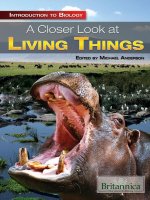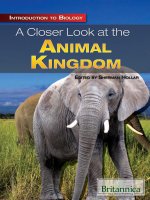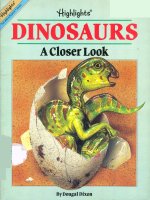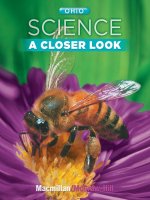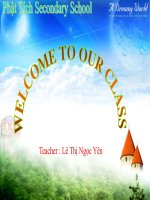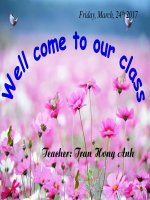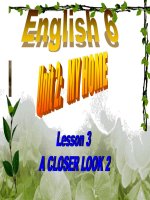Macmillan 08 grade k 02 science a closer look
Bạn đang xem bản rút gọn của tài liệu. Xem và tải ngay bản đầy đủ của tài liệu tại đây (9.18 MB, 48 trang )
Content Consultants
Robert L. Kolenda
Patricia Cavanagh
Science Coordinator, K-12
Neshaminy School District
Langhorne, PA
Elementary School Teacher
Merrimac Elementary School
Holbrook, NY
Paul Mulle
Pat Marengo
Science Supervisor
Camden City Schools
Camden, NJ
Sixth Grade Teacher/Technology
Specialist
District 58 Elementary District
Downers Grove, IL
Students with print disabilities may be
eligible to obtain an accessible, audio version
of the pupil edition of this textbook. Please
call Recording for the Blind & Dyslexic at
1-800-221-4792 for complete information.
Internet Disclaimer
Visit www.macmillanmh.com to learn more
about technology. You will also find links to
other Web sites. These Web sites are not run
by Macmillan/McGraw-Hill. When using the
Internet, be safe and protect your privacy.
Make sure a teacher, parent, or guardian is
around. Never tell someone your full name,
address, passwords, or other personal
information. Do not respond to e-mails or
messages from strangers.
Copyright © 2008 by Macmillan/McGraw-Hill. All rights reserved. No part of this publication may be
reproduced or distributed in any form or by any means, or stored in a database or retrieval system, without
the prior written consent of The McGraw-Hill Companies, Inc., including, but not limited to, network storage
or transmission, or broadcast for distance learning.
Send all inquiries to:
Macmillan/McGraw-Hill
8787 Orion Place
Columbus, OH 43240-4027
Printed in the United States of America
ISBN-13: 978-0-02-286123-0
ISBN-10: 0-02-286123-8
3 4 5 6 7 8 9 073/073 10 09
ii
Lesson 1 • We Use Tools . . . . . . . . . . . . . . . . . . . . 2
Technology in Action: A Tool to Look Inside . . . . . . . . . . . . 6
Tech Activity: Make Your Own Tool . . . . . . . . . . . . . . . . . . . 8
Lesson 2 •
Materials and Their Uses . . . . . . . . . 10
Technology in Action: Making Money . . . . . . . . . . . . . . . . 14
Tech Activity: Classroom Properties . . . . . . . . . . . . . . . . . . . 16
Lesson 3 •
Parts Work Together . . . . . . . . . . . . . 18
Technology in Action: Put Parts Together . . . . . . . . . . . . . 22
Tech Activity: Make a Wagon . . . . . . . . . . . . . . . . . . . . . . . 24
Lesson 4 •
Whose Idea Was That? . . . . . . . . . . . 26
Technology in Action: Turn It On! . . . . . . . . . . . . . . . . . . . . 30
Tech Activity: Making Paper . . . . . . . . . . . . . . . . . . . . . . . . 32
Lesson 5 •
From Idea to Invention . . . . . . . . . . 34
Technology in Action: Testing, Testing . . . . . . . . . . . . . . . . 38
Tech Activity: Design a Juice Box! . . . . . . . . . . . . . . . . . . . . 40
Do You Remember? . . . . . . . . . . . . . . . . . . . . . . . . . . . . . . . . . . . .42
Glossary . . . . . . . . . . . . . . . . . . . . . . . . . . . . . . . . . . . . . . . . . . . . .44
iii
We Use Tools
Vocabulary
tools
technology
X-ray
You can use a shovel
to dig in soil.
Tools help us do things.
What tools do you use
every day?
You need a hammer to
build a bird house.
Scissors are tools, too.
2
All the tools and ideas we
use are called technology.
Technology can make our lives
better. Technology helps us
travel, communicate, and stay
healthy and safe.
People have always used tools
and ideas. New ideas and tools
can make work easier.
broom
What are tools?
Tools Then and Now
Read a Photo
How are these tractors different?
How are they the same?
3
Technology Can Help Us
Technology depends on
science. Science depends
on technology, too.
Tools help scientists
experiment and
explore.
↓ Technology can tell us
about the weather.
4
A telescope is a
tool. It lets us see
faraway objects
in space.
Sometimes helpful tools can harm
us. We must be careful how we
use them.
Helpful and Harmful Technology
Cars help us get from place to
place. But cars can also pollute
the air.
Medicine helps us stay healthy.
But it can have harmful side
effects, too.
Music players help us enjoy
songs. But if we play the music
too loud, it can harm our ears.
How can technology
be helpful? How can
it be harmful?
5
Can you see inside your
body? No, but a machine
can. It takes special pictures.
They are called X-rays.
X-rays go through skin and
muscle. They can not go through
bones. So bones show up on
X-ray pictures.
6
↑ This is an X-ray
of a broken arm.
Dentists take X-rays. They
want to see how your
teeth are growing. They
also look for cavities.
Doctors and dentists look
at X-rays to see what is
wrong inside. Then they
can fix it.
↓ What do you notice about
the teeth in this X-ray?
This girl is getting an
X-ray of her teeth.
*6A@j 7DJIj I
Summarize. When might a
doctor or dentist need to see
what is inside of you?
7
You need
paper
towel tube
Make Your
Own Tool
What to Do
Use a paper towel
tube as the handle
for a broom.
scissors
Cut paper. Put it on the end
of the paper towel tube.
paper plate
Investigate. Use your broom
to sweep an area of your
classroom. Collect the dirt in
a paper plate.
tape
glue
8
Draw Conclusions
How is your tool like a
real broom?
Complete each sentence.
1. Something that helps us do
things is a
.
tool
X-ray
2. A special picture of inside
your body is an
.
3. What are some ways
technology helps us?
4. What are some ways
technology harms us?
Which tool do you use most to
help you do work? Draw yourself
using that tool.
-0(
0/
-Tech Link For more on tools check out www.macmillanmh.com
9
Vocabulary
natural resources
properties
mint
Materials and
Their Uses
Materials are either made by
people or nature. Materials
made by nature are called
natural resources. Natural
resources come from Earth.
Using Natural Resources
RESOURCE
PRODUCT
10
wood
corn
chair
cereal
Plants and animals are living
natural resources. Land, minerals,
water, and air are nonliving
natural resources. We use both
kinds of natural resources.
What do you see in your classroom
that is made from wood?
iron
sand
wool
nails
glass
clothes
Read a Chart
What can we use wood to make?
11
Properties of Natural
Resources
cotton
We use natural resources
to make new materials.
Materials have different
properties. Properties are
how something looks,
feels, smells, or tastes.
Properties make materials
good for some things, but
not for others.
Cotton is a natural
resource. Softness is
a property of cotton.
Cotton balls would not
make a good bridge.
12
We use many things made
of plastic. Plastic does not
grow in nature. People
make plastic. It can be soft
or hard. It is very strong.
Some natural resources are
limited. That means they
will not last forever.
How are cotton and plastic
different?
You can help save Earth’s
resources by recycling
things made from plastic.
13
Do you know where money
comes from? A mint is a place
where money is made.
← First, metal is melted.
Then it is poured out.
→ Then a machine cuts
metal into circles.
14
↑ The circles are then stamped
by a coin press.
↑ Lastly, they are placed
into coin bags. Then
they are sent to banks.
Each state has its own quarter.
*6A@j 7DJIj I
Infer. How are coins made?
15
Classroom Properties
What to Do
Observe. Look around your
classroom. Collect five items.
Record Data. Make a chart like
the one below. Draw the items
you collected. Check off which
properties each item has.
Draw Conclusions
Did any of your items have the
same properties?
16
Complete the sentences below.
1. Materials made by
nature that come
from the Earth are
called
.
properties
natural resources
2. How something looks, feels,
smells, and tastes are its
.
3. What is cotton good for?
What is it not good for?
4. Write about what you ate
for breakfast. Where did
the foods come from?
Draw your favorite toy. What is it made
of? If you do not know, ask an adult.
Then write it under the picture.
-Tech Link For more on tools check out www.macmillanmh.com
17
Vocabulary
system
electricity
Parts Work
Together
Many objects have parts.
Each part is important. The
parts work together to make
the object work. If just one
part is missing or broken,
the object will not work!
A wheel is one
part of this object.
Which one of these trucks will work?
How do you know?
18
A system is a group of parts that
work together. A highway system
has roads, streetlights, and cars.
These parts work together. They
get people where they want to go.
Can you think of some other
systems?
highway system
19
Systems at Work
A computer is a system, too. It has
parts that work together.
Parts Make Them Work
monitor
The monitor and
printer are parts that
show information.
printer
mouse
The keyboard and
mouse are parts for
putting information in.
keyboard
CPU
The CPU is the Central Processing Unit.
It is the “thinking” part of the computer.
20
A lamp is also a system. It has
parts that work together to
make light.
A lamp has a lightbulb. It also
has an electric cord that comes
out of the the lamp. The cord
plugs into an outlet in the wall.
Electricity makes the lamp
work. Now you have light! light bulb
What could be wrong if
a lamp will not turn on?
switch
Read a Diagram
What would happen
if a computer’s
keyboard was broken?
electric cord
electric outlet
21
Wagons have parts.
When put together, all of
these parts make a wagon.
On their own they are
just pieces.
These are all of the parts
of a wagon.
22
You can put an axle and
wheel together. This lets
the wheels spin.
Then, you can put the box
above the wheels. This
lets you put things in the
wagon.
Lastly, you can attach a
handle. This lets you pull
the wagon.
*6A@j 7DJIj I
Cause and Effect. What
might happen if the
wagon did not
have a handle?
23
